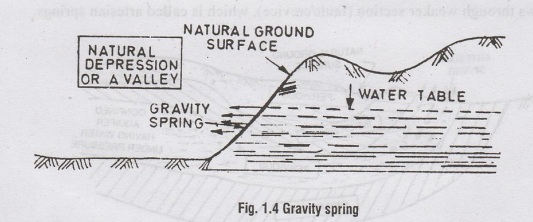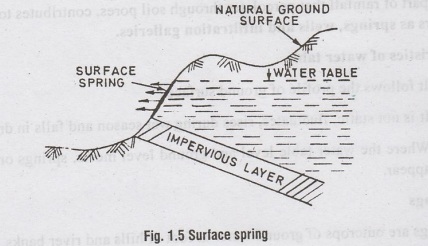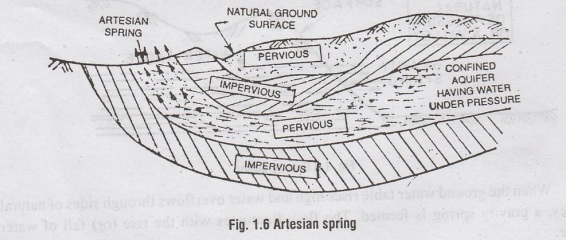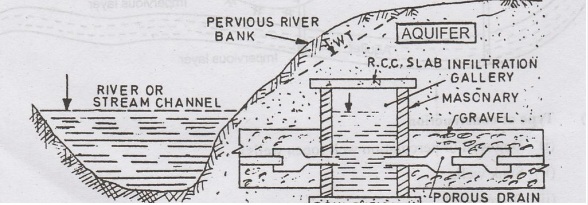Water Supply And Wastewater Engineering: Unit I: Water Supply
Ground Water as a Source of Water Supply
The part of rainfall that percolates through soil pores, contributes to ground water and appears as springs, wells and infiltration galleries.
GROUND WATER AS A SOURCE OF WATER SUPPLY
The
part of rainfall that percolates through soil pores, contributes to ground
water and appears as springs, wells and infiltration galleries.
Characteristics of water table
a.
It follows the profile of ground surface.
b.
It is not static, fluctuates, rises during wet season and falls in dry season.
c.
Where the water table level and ground level meets, springs or streams may
appear.
1. Springs
Springs
are outcrops of ground water at foot of hills and river banks. The different
types of springs are:
a)
Gravity springs
b)
Artesian springs
c)
Surface springs
(a) Gravity springs

When
the ground water table rises high and water overflows through sides of natural
valley, a gravity spring is formed. The flow fluctuates with the rise (or) fall
of water table.
b) Surface springs

Surface
springs are formed when an impervious stratum supporting underground storage
becomes inclined causing the water table to rise up and get exposed to the
ground surface.
The
quantity of water in these springs is uncertain.
c) Artesian springs
When
the water bearing strata between two impervious strata is under pressure, the
water flows through weaker section (fault/crevice), which is called artesian
springs.

2. Wells
Well
are vertical cylindrical openings from surface to a water bearing: formation
Classification
a) Based on the type of
Aquifer tapped
(i) Shallow wells
•
Tapping of uppermost water bearing strata
Drawbacks:
•
Large fluctuations in yield soon tab-img
•
Quality of water is poor
(ii) Deep wells
•
Tapping of deeper and larger aquifers
b) Based on the
Condition of flow
(i) Gravity well
Water
flows under gravity into the well under atmospheric pressure.
(ii) Pressure well
Aquifer
is confined between two impervious strata. Water flows under pressure greater
than atmospheric pressure.

c. Type of construction
(i)
Dug well or percolation well (open wells)
(ii)
Sunk wells
(iii)
Driven well
(iv)Tube
well
(i) Dug wells
-
Shallow wells with masonry walls. The well sinks under masonry weight
-
More masonry is added and excavation proceeds till the required height.
-
Cheap and easy construction
-
Useful for Villages and small Towns
- Quality - water is easily contaminated
-
Quantity - Larger diameter increases
the yield.ut
(ii) Tube wells
Constructed
by drilling auger boring into ground using machinery
Types:
Deep
and shallow wells.
Methods
of drilling
(a) Percussion drilling
(b)
Core drilling.
(c) Rotary drilling
Storage capacity of ground water
Storage
capacity depends on
(i)
Porosity of soil (Percentage of voids to total volume)
(ii)
Permeability of soil (ability of rock to pass water)
3. Infiltration
Galleries
These
are horizontal tunnels/wells constructed at shallow depths along the river bank
for tapping water.

An
infiltration gallery is constructed of mansonry walls with roof slab and
extracts water from aquifers by various porous lateral drain pipes. The pipes
are covered with gravel to prevent entry of sand and particles. The galleries
are laid at slope and water collected in them is taken to a sump well, from
where it is pumped.
The
discharge from infiltration gallery is computed by

K
- permeability coefficient of aquifer
L-length
of gallery
R-
radius of influence
H-static
water level
h
- depth on pumping equilibrium
Water Supply And Wastewater Engineering: Unit I: Water Supply : Tag: : - Ground Water as a Source of Water Supply
Related Topics
Related Subjects
Water Supply and Wastewater Engineering
CE3303 3rd Semester Civil Dept 2021 Regulation | Tag: 3rd Semester Civil Dept 2021 Regulation
